In this guide, I am going to show you the easiest way to build your own working, stunning, beautiful and unique deck.
I’m no 6,000 Grandmaster player, there are better players than me, and some of them are regular Redditors here.
BUT, I’ve learned enough that there are at least a few of you who could take something useful away from this, I hope.

Deck Elements
So if I (a madman) want to build my own deck what is the things I need?
Let’s start by describing the categories I place cards and combos into.
A deck doesn’t need every one of these, and it’s possible to build a deck that has none of these, but I’ll list out what I view as the pros and cons of each element.
Side note, cards can fit into multiple categories here, and sometimes a combination of cards would fit into a category, but one individual piece of the combo wouldn’t.
Hard Ground Stop

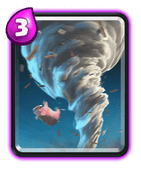


 Ground Stops are the cards you can play to just slow everything down and eliminate a push.
Ground Stops are the cards you can play to just slow everything down and eliminate a push.
They are cards you can drop against medium(6-16 elixir) sized pushes, generally they have a lot of hit points, and can survive for a bit while your towers whittle down attackers.
Combos like Tornado +Executioner, or cards like the Giant Skeleton and Mega Knight fit into the category of ground stops.
- Pros: A hard ground stop makes it much easier to defend big beat-down style pushes, and certain types of ambush plays (I’m thinking of you elite barbarians!).
- Cons: Cards and combos like this can be expensive, to the point of dramatically defining how you can play
Air Stops
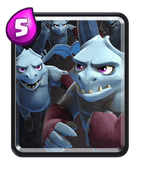



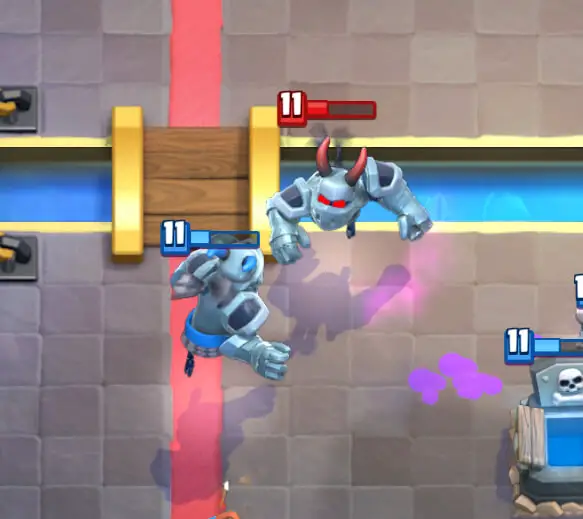 All flying cards, on account of being completely immune to half of them, are weaker than their ground-based counterparts.
All flying cards, on account of being completely immune to half of them, are weaker than their ground-based counterparts.
The Lava Hound does not compete with the Golem in Beatdown, unless you accompany it with other flying cards.
The main advantage to air cards is that they can kill off your ground-only troops damage free, so you’ll want the air-targeting troops to escort your walkers to the tower, and to shutdown balloons or bats harassing your troops and towers on defense.
Most of the time you’ll want 2 or more air-targeting troops in a deck, since just one tends to be easily overwhelmed by a Balloon or Lava Hound deck.
- Pros: Air troops have a huge advantage so being able to kill them is an absolute must if you’re trying to get a Pekka, Giant or Hog to the tower
- Cons: Ground-only troops tend to be stronger than the troops that can hit air, so it’s worth taking them.
Win Conditions




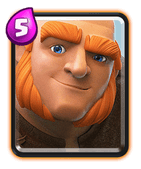
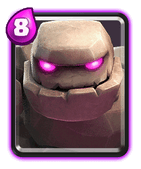
 Win Conditions consist of Primary, Secondary and Tertiary win conditions.
Win Conditions consist of Primary, Secondary and Tertiary win conditions.
Primary Win Conditions
Troops that target buildings or can be deployed directly to target a tower (like the miner).
- Pros: These will be your most cost effective ways to deal tower damage, and are much harder to stop via distraction tactics.
- Cons: These cards tend to be weaker or useless on defense, so you can end up with a dead card in the middle of a defense
Secondary Win Conditions
These are cards that are either easily distracted, or easily countered, and so while powerful they aren’t reliable as a way to kill the tower. Cards like the Pekka, Mega Knight and Minion Horde can fit this role, as can a heavy spell card.
- Pros: These cards are much better at defense than Primary Win conditions, and can fill multiple roles.
- Cons: These cards tend to be less effective at tower-killing and if you rely too much on on these to deal tower damage, frequently a good defensive player can shut down your attacks and either play for the tie, or grind you down by being better at defense.
Tertiary Win Conditions
These are cards and combos that aren’t really good at killing towers. They’re too easily countered, or distracted. They serve other roles, but can deal significant damage. Cards like the Princess, Goblins (any kind), spawners, and Bats fill these roles.
- Pros: These cards serve roles the other win conditions can’t.
- Cons: Being bad at killing towers, you bring too many of these and you’ll find it impossible to win.
Swarm Killers

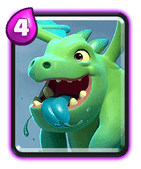




 Swarm troops are one of those secondary or tertiary win conditions and can be extremely deadly, most decks should have one or more solutions to shut down a horde of angry birds or Larrys, since a good swarm card can shut down a lot of win condition cards
Swarm troops are one of those secondary or tertiary win conditions and can be extremely deadly, most decks should have one or more solutions to shut down a horde of angry birds or Larrys, since a good swarm card can shut down a lot of win condition cards
Pros:
- You can pair most splash damage troops with Tornado to create a fairly effective Ground Stop.
- They make excellent escorts for walking(/flying) win conditions to keep them from being killed or distracted.
Cons:
- They tend to be more expensive, easier to kill.
- Have lower damage output than their single-target counterparts.
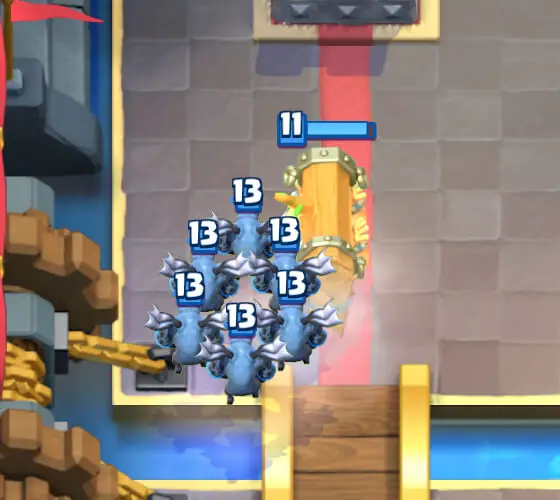 Pressure
Pressure




Pressure cards/combos must be answered right now. They force your opponent’s next moves.
Pros:
- Force your opponent’s next few moves which can be a useful way to defeat beat-down pushes before they even start
- Disrupt your opponent’s defenses so you can break through.
Cons:
- Pressure attacks that get well countered are wasted elixir, and usually at a bad time
- Adding cards to your deck for the purpose of causing pressure can reduce your ability to support your main attack.
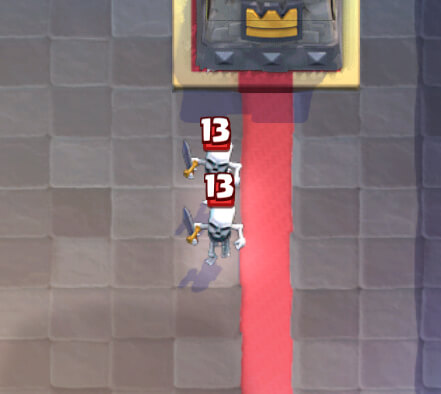 Cycle
Cycle





Cycle Cards you already know. Cheap cards costing no more than 3 elixir, but usually in the 1 or 2 elixir cost.
Pros:
- Smart use of these cards allows you to defend at an elixir advantage
- Allow you to play as though they have 6 cards instead of 8. Is this useful? Well it depends on your other 6 cards, but it can frequently allow you to out-cycle your opponent’s good counter-plays. If his only good hog defense is a tombstone, then by playing hog every 5th card you’ll eventually get to the point where he doesn’t a tombstone and you score big damage.
Cons:
- They tend to be very weak, by themselves, and a well supported combination push can render these Dead Cards in your hand on a defense.
- They are also limiting, your “main” cards will need to be a good combination on offense and defense to make up for these choices.
Investments




 Investment cards are slow-moving cards like the Ice Wizard or Archers. They are basically the opposite of pressure cards.
Investment cards are slow-moving cards like the Ice Wizard or Archers. They are basically the opposite of pressure cards.
They can be used to stack elixir up in a lane for a big beat down push, but you can also use them defensively as a way to deny (or reduce) your opponent’s ability to attack a given lane.
Pros:
- Being slow moving is useful when trying to build up an attack, or to defend against high pressure attackers.
Cons:
- Being slow moving makes it hard to create pressure on your opponent, which can make it hard to clinch a tight game, or to defend against a big beat down attack.
- It also leaves very little room for a Hail Mary style last-ditch-effort attack.
Supports







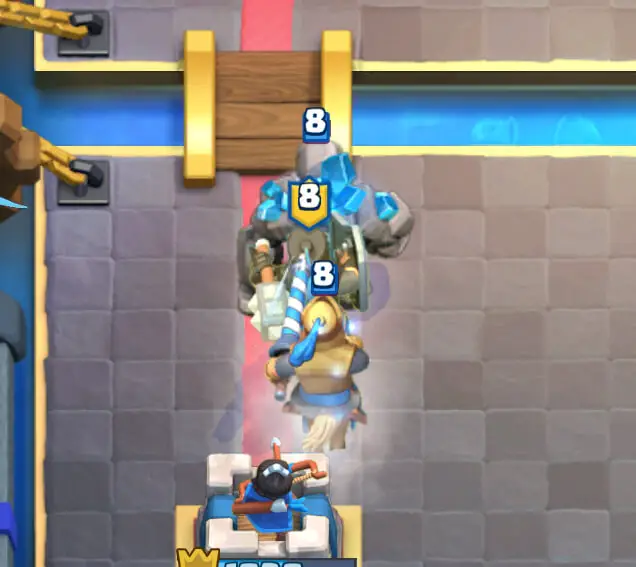 Support cards are anything you use to help ensure that your attacks actually get to the tower. These cards always fit into multiple categories and most are useful on defense.
Support cards are anything you use to help ensure that your attacks actually get to the tower. These cards always fit into multiple categories and most are useful on defense.
They are cards you use to help that your main tower-attacks actually kill the tower.
It might be a Poison Spell or an Ice Golem if you’re using a Graveyard for damage. It might be a Wizard or a Night Witch if your main attack is the Golem.
It’s useful to think of multiple ways supports can be combined since most good win conditions can be countered, and it’s a good idea to have a back-up plan which uses the same support cards in different ways.
- Pros: Every good win condition can be supported to make it more effective, and to help break through the opponent’s defenses.
- Cons: Support cards aren’t necessarily, useful attack cards by themselves. You need to be thinking about how they combine with other cards to make powerful combinations. Bringing too much support can make your deck feel underwhelming and weak, especially if they have a way to defeat your main win condition. If they have a poison spell, for example, your graveyard can be rendered completely useless and the supporting cards are then easily dealt with.
Pocket Cards





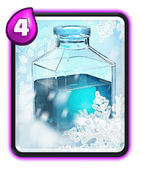
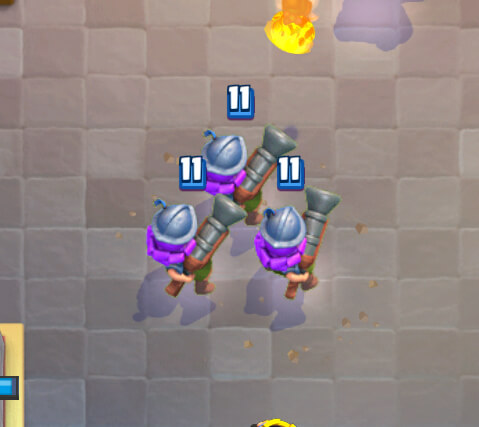 Pocket cards are cards that you include in your deck, but don’t play in every match. They are kept as a situational high reward card, and can be very effective when revealed late in a match.
Pocket cards are cards that you include in your deck, but don’t play in every match. They are kept as a situational high reward card, and can be very effective when revealed late in a match.
They are often used to catch your opponent off guard and punish them heavily.
They can be very effective if not revealed the entire match, and can be very devastating for your opponent if they are not able to react to your “pocket card” properly.
-duck_635
The last concept I’ll address is the pocket card. No deck “needs” a pocket card, but they can be quite fun to use.
Pros:
- They’re fun
- They are frequently game-changing.
Cons:
- Pocket cards can often be a dead card, until you find an ideal situation to use them in. This leaves you playing with a 7 card deck and only 3 cards in-hand, which is a serious disadvantage.
- You must be able to find an excellent use for a pocket card in at least some matches, or it’s not a worthwhile addition to your deck.
Deck Building
Start With a Concept or Card
 Making a new deck, especially one that can compete in ‘real’ play is quite challenging, and staring at the 73 cards in the game can leave you feeling overwhelmed.
Making a new deck, especially one that can compete in ‘real’ play is quite challenging, and staring at the 73 cards in the game can leave you feeling overwhelmed.
If you want to create an undead deck you probably can’t just throw 8 zombies together and have something useful. But it’s a good place to start.
Pick a theme, or pick a card you want to use (like…. maybe it’s an unpopular card like the Cannon Cart and you’re a deck hipster)
Pick a Win Condition
 So regardless of what your starting point is, you need a way to destroy the tower.
So regardless of what your starting point is, you need a way to destroy the tower.
Did you pick a support card?
Then think about whether that card is best at supporting.
Is it frail and best behind a distraction (like the Musketeer), or is it mainly a defensive card (like the hunter)?
Did you pick a tank?
Tanks are frequently quite limited what they can do, and will like some support cards.
If you picked the mega knight then you probably want to consider how to get him to the tower.
He’s good at clearing swarms so you probably want something high damage to kill the things he’s bad at killing.
Did you pick a theme?
Start by selecting two or three cards that fit your theme. Either you’ve got a win condition, or you’ve got support cards.
Think about what those support cards combine with best to create a win-condition style push.
If you’ve got wizards to blow away the swarm troops, then you might want to consider a Giant or Battle Ram that would appreciate a splashy escort.
Pick a Secondary Win Condition
 Skeleton Barrel or Graveyard are pretty easily countered win conditions. Every win condition in the game can be very easily defeated by something.
Skeleton Barrel or Graveyard are pretty easily countered win conditions. Every win condition in the game can be very easily defeated by something.
If your opponent has the right combination of cards you need a way to ensure you can actually deal tower damage.
Here are a couple of options:
Bait
If your first win condition is hard-countered by poison, and you discover your opponent has poison you might want to consider baiting out the poison as a way to actually defeat him.
Cards like the Goblin Hut, Furnace or Skeleton Barrel are good options that would allow him to mis-play a poison spell.
Baiting is the premise of the Goblin Barrel deck you all love/hate.
Alternative
If you have a Hog, and your opponent hard-counters him with a Mini PEKKA or a Tornado, then you might be in for a rough match.
By picking an alternative win condition that functions differently, like the Giant, or Goblin Barrel you can use a completely different style of attack to deal the damage.
Double Down
By bringing a mirror or a different win condition that functions similarly you can force out your opponent’s hard-counter defense and be ready with your alternative as soon as that threat is neutralized.
For example, you could bring both Hog and Battle Ram, and once the Mini P.E.K.K.A has been played to defend one of them you’re free to attack the tower, either in the opposite lane or in the same lane (post P.E.K.K.A).
Cycle
By simply playing the win condition more often than they can counter it, you can defeat the problem of a hard-counter by playing your attack card frequently enough they can’t defend it.

Big Spells
At this point you probably have 4-6 cards picked out.
Most decks should have a heavy spell.
Failing to bring one will leave you at the mercy of Elixir Pumps, and with no way to force the last 200hp on the tower in close matches.
So how do you pick one? Look at what your deck already has and use your spell to strengthen a weak spot.
 Poison
Poison
Poison is good at area denial and chipping away small troops, and dealing with spawners.
It pairs nicely with Graveyards and Miners, but can be effective in beat down decks.
 Lightning
Lightning
If your deck needs a way to kill a multiple supporting troops (like Ice Wizard and Musketeer) tucked safely behind the tower this is your choice.
Defenses like this are most common against beat-down decks, so if you’re running a beat-down deck this is a good choice.
It’s also effective at destroying a big beat-down push by taking out the supporting units behind it so you can use Skeleton Army to destroy the tank.
 Fireball
Fireball
Fireball is good at killing swarms and its knock-back can be used to drive a support card like the Musketeer (now injured) forward so that she cannot hide behind the tower.
Paired with a Tornado, Log or Zap it’s an effective (albeit expensive) killer of supporting troops.
 Rocket
Rocket
Rocket is mainly useful to deal tower damage or eliminating critical threats like Bowlers, and Inferno Dragons, but paired with a Tornado it can make an effective ground stop.
Small Spells



Small spells aren’t a requirement, but you’ll frequently want them.
Generally one is sufficient, adding two (if you already have a heavy spell) can leave you in “dead card” territory.
Can I beat a Goblin Barrel?
If you have no good troop-based counters to the Goblin barrel, you’ll want a Log or Arrows (or changing your troops)
Can I beat a Minion Horde?
If the answer to that is no, you’re going want to consider adding Arrows (or changing your troops)
Do I need to worry about Skeleton Army or Bats on offense?
This makes an argument for Zap. You might already have a splash troop you plan to run behind a Golem, and you may not need Zap.
Having a Poison Spell can negate the need for Zap on offense.
Do I have splash troops?
Tornado is never a requirement, but Splash Troops can be paired with tornado to devastating effect on defense.
Having at least 2 splash troops makes a strong argument for including Tornado.
Check the Deck Elements
Ask yourself which deck elements you currently have. Not filling a category is not a deal breaker. The whole point is to think about what your deck will be good at.
Ground Stop
If you don’t have a ground stop, then how will you defend a big beat-down death ball? Will it be a high pressure attack to prevent them from building the death ball in the first place? Can you create pressure with the cards you currently have?
If your opponent is cycling
How will you keep up? Do you have multiple solutions to hog-riders ?
How does this deck play?
Is it slow investment cards for a big beat-down attack? Should you consider changing win-conditions because your support cards are all slow but your win condition is a hog rider? Battle Rams like offensive support more than a hog rider, so do giants….
Do you have potentially dead cards, and do you have too many?
A hand with 4 cards that aren’t troops can be a huge disadvantage
Is your deck expensive?
Do you want to consider swapping in a cycle card to help reduce cost and make the deck play a little faster?
Check your Battle History
At this point your deck is more or less completed, so it’s time to consider whether you can beat the Meta.
If your battle history shows a lot of Hog Riders then you should ask the question “How will I defend a Hog Rider?.
Add or Swap cards until you’re fairly comfortable with the defenses you’ll have to make. Then ask yourself if you can still get damage to kill the tower, and swap cards until you’re comfortable you can.
Repeat this process until you feel like you’re ready to give it a try.
Play Test
Break into a few friendly battles or 2v2 Matches until you’re comfortable with the combinations of cards you’ll use to attack and defend.
If you have any major holes, then someone will probably stick a finger in them, and that’ll tell you you have a problem.
So start making trades.
Sometimes you need to swap 2 or even 3 cards to fill one hole without creating another.
Prime Time
It’s time to start “real” play so bust out a classic challenge (grand if you’re already super confident in the deck) or start laddering.
Remember, trophies are just as easily won as they’re lost so give it several matches to get comfortable before making changes.
Conclusion
This is the process I go through when deck-building. Hopefully at least a few of you will find this useful. Let me know what you think.
Shared by darchangels13


![Deck Of The Month – Vote for The Best! [September]](https://clash.world/wp-content/uploads/2017/07/mortar.jpg)

